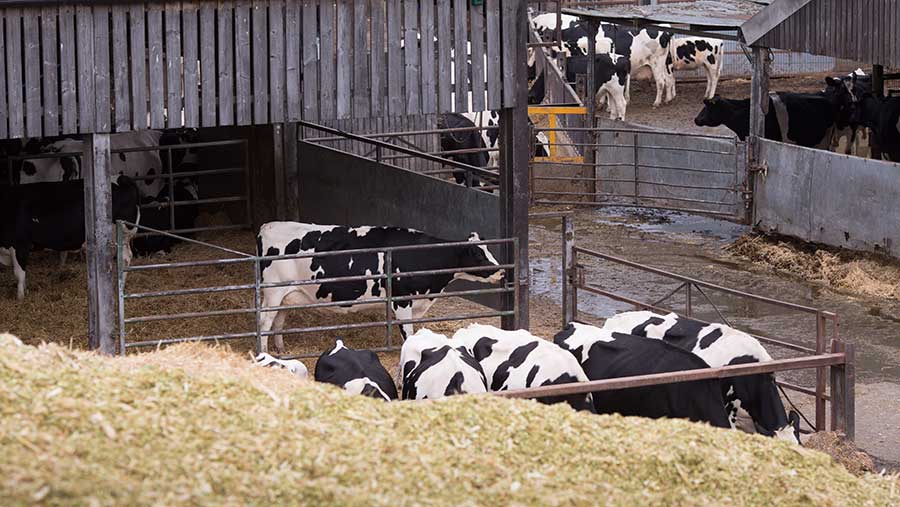Advice on feeding this year’s maize as stocks look tight
 © Tim Scrivener
© Tim Scrivener Initial samples show maize quality looks good, despite the unprecedented growing season during which crops were planted late and had to cope with drought conditions in the summer.
Results of the first 500 samples analysed by Trouw Nutrition show on average:
- Dry matter is 32.8%, with a higher proportion of drier crops as a result of the summer weather
- Energy levels are 11.7MJ/kg DM
- Starch is 31%
However, 15% of samples were inadequately fermented, which suggests farmers rushed to get the feed into diets to make up for reduced forage stocks.
See also: How to minimise maize losses as feed supplies tighten
Dr Liz Homer, ruminant technical development manager for Trouw, says feeding incompletely fermented crops should be avoided if possible.
“The fermentation will be unstable, increasing the risk of spoilage, while any analysis will not be representative of the final feed.”
However, farmers will have to pay closer attention to diets to prevent acid loading, as this year’s crop has a high acid load, in part due to increased starch levels and high starch degradability.
“The outcome is that maize is high in rumen-fermentable carbohydrates that will contribute to diet acid loading. It may be prudent to replace cereals with more fibrous energy sources like soya hulls to help balance the rumen.”
Analyse crops
Independent nutritionist Hefin Richards of Rumenation says maize quality generally varies from “OK to very good”, but warns that averages can be misleading. He advises farmers to get maize clamps analysed.
For instance, Mr Richards says ME was lower on farms that cut crops lower down the stem in an attempt to increase bulk, but generally, moderate-yielding crops had very good cob development and consequently have above-average starch percentages because of the plant-to-cob ratio.
“At farm level what matters is what you have got.”
Top tips for feeding maize
- Feed an absolute minimum of 40% forage in milkers’ diets, even where stocks are limited. Be aware that high-starch maize is not really a true forage in terms of maintaining rumen health in high-concentrate diets. This may need balancing with additional rumen-friendly fibre such as NIS, chopped straw, sugar beet pulp or soya hulls.
- To keep the diet as consistent as possible, regularly review forage stocks and plan ahead.
- After three months, maize starch will become more readily available as the protein matrix that binds it is broken down by silage acids. Ideally, you shouldn’t feed maize in the year you make it, but with forage stocks low this will be a challenge this year and probably next year as well.
- If you have already started feeding maize or you are only feeding a small amount, be careful of clamp wastage. Instead it may be better to have a separate, smaller clamp of maize in future if you do plan on feeding it before January to avoid letting air into the main pit and causing aerobic spoilage throughout the main clamp.
- If you have two pits of maize – one at 30% DM and another at 36% DM – feed the lower-DM maize first because starch will ferment more rapidly. A crop that’s more mature needs longer to ferment before the starch availability improves.
Forage stocks down
Mr Richards says yields are down by about 15-20% on average and this will put pressure on stocks heading into next summer and autumn for many units reliant on feeding maize all year round.
“The challenge will be having enough maize to get through to November next year to avoid either running out and putting pressure on 2019 grass silage stocks, or having to feed very fresh maize in 2019.”
He says if it isn’t feasible to feed all year, farmers should target it to best effect. He says this may mean feeding it alongside the poorest-quality grass silage for a few months or directing it at peak-yielding cows.
Advice to avoid big diet changes
To avoid big changes in the diet, Mr Richards recommends reviewing stocks monthly.
“It is far better to feed 12kg all year round than feed 15kg and drop to 9kg. There’s no point in feeding less than 2.5kg DM of maize [per cow].”Very low use also leads to more wastage at the clamp face.”
